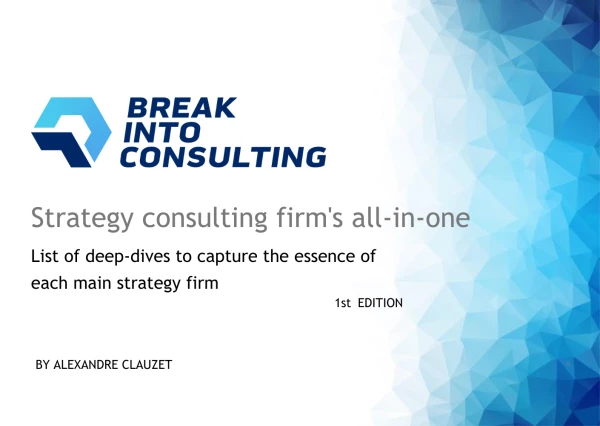Hi everyone!
I have recently passed initial rounds of interviews at one major scandinavian consulting firm. For the next round, they have already send me the case and asked me to prepare a presentation with my solutions. So far I have only practiced cases which are given during the interview and I'm therefore not sure how to approach this.
Does anyone with experience with this have any tips or advice?
Thanks a lot!
Maros
Recieving case one week before interviews and preparing presentation


To solve the case I would use the same approach used for oral case interviews but I’d go way deeper given that there is way more time and that likely is the expectation. I would also make sure you use (but don’t abuse) all the tools available to you to solve the case within the rules and guidelines they give you (e.g. if allowed make sure you do all the following - and more: reaching out back to them to ask clarifying questions, using spreadsheets or other software to model do analysis, do google searches for fact base etc).
Onto the written document itself I think the key in my opinion is to have it divided in two parts: main presentation and appendix. The main presentation is where you will present your recommendation to the interviewer(s) while the appendix is where you have all the back-up analysis that helped you come to that specific recommendation and eliminate others.
Indicatively the length of the main presentation should be 7-10 content pages (meaning you exclude from count cover, agenda and divider pages) if you have 30 mins to present, 15-20 if you have 1 hour. These times refer to presentation only time and do not include Q&A/discussion. You want it to keep it short and poignant.
I would organize the presentation into the following blocks:
-Executive summary (1 page all text that goes through the whole story)
-What we’ve heard from you and context (1-2 slides about problem statement, data behind it, and broader context)
-Decision framework (1 slide with decision framework dimensions and your assessment for each of them)
- [if you have long presentation time this goes here, otherwise in appendix] deep dive on each dimension of decision framework (1 page for each dimension of analysis and insights)
-Recommendation and impact summary (1-2 slides that provide your recommendation and it’s impact)
-Next steps (1 slide what would you do next to implement recommendation, what follow ups would you do)
General guidelines for the written presentation:
-The first thing you should do is to write your executive summary. You should write it as the story you would like to tell to the interviewer. Each sentence/paragraph should correspond to a slide you are going to present in your main deck. Each sentence paragraph ideally correspond closely to the main insight, and therefore title, of each slide of the deck. First write your story then design your slides, not viceversa. This because it’s easy to fall in the “trap” of getting “in love” with our own slides and adapt the story to fit the slides vs. telling the most clear and powerful story.
-Keep you titles consistent: either they are all action titles (Market growing at 5% YoY) or all descriptive titles (Market size evolution). Most consultancies prefer action titles
- Slides should present insights, not just data (e.g. don't just show that market growth is 5%, tell why it's relevant)
Style cheat-sheet (in no particular order):
- Minimum font is 12pt except for footnotes
- Put sources on each slide
- Make slides graphically appealing and consistent with each other (e.g. same colors for same metrics from slide to slide, consistent wording to indicate same concept)
- If you have access to any of the consultancy presentation try to mimic their format/style
- Max 1-2 key messages per slide
- One line slide titles are better than two line ones, fewer words are better than more, ~50 words max per slide (except exec summary)
- Align of objects within slide
- Don’t use abbreviations or not well-known acronyms (so ok to use EBITDA for example), if you have to, footnote them
- Make sure to do a spell check, twice (see title of your question)
- On graphs always remember to put unit of measure on both axis, and notable numbers on axis and magnitude (e.g. ‘000 widgets, $M, etc)
Please reach out directly if you have further questions or want advice
Hope it helps,
Andrea

Hi Maros,
I agree with Andrea’s points. I have reported below two additional suggestions on content and presentation:
Content of the slides
There are three basic components for each slide:
- Title
- Chart or data
- Label for chart
I will focus mainly on the title point, as that’s what usually people design incorrectly. Many people indeed structure the title as the mere description of what the chart is telling. A great title, instead tells the implication of the graph. Eg say the graph is showing a cost structure for a division. A bad title would be: Cost structure from 2005 to 2015. A good title would be: Cost structure of Division XYZ is not sustainable”. A great title would be Cost structure of Division XYZ is not sustainable due to ABC, assuming you have insides on the cause. The rule of thumb for the title is that if you read all the titles of the slides together you should get a clear idea of what is going on.
For graphs, I would suggest to keep it simple when possible. Column bar graphs, line graphs and histograms should usually be enough.
Finally, be sure to add the proper label and/or unit measures.
Slides presentation
When you present, I would suggest the following steps for each slide:
- Introduce the slide: “Let’s move to slide 2, which will show us why we have an issue with this division”
- Present the main message of the slide: “As you can see, we have a cost structure which makes for us not feasible to be competitive in this market”
- Provide details: “The graph, indeed, shows how our fix cost is XYZ, while competitors can benefit from economies of scale. Indeed…”
Hope this helps,
Francesco












